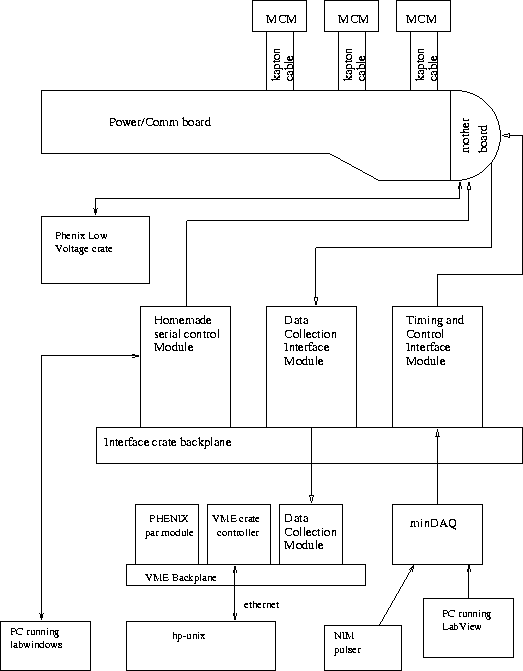
|

|

|

|
Notes about MVD chaintest
The MVD chaintest currently uses the following hardware:
and the following computers:
and the following software:
Here is a sketch of the setup:

Look here for a description of the DCIM output packet format.
Results so far
Look here for a report of progress sent out 18-Oct-99.
Look here for a report of progress sent out 21-Oct-99.
Here are misc other relevant email messages whch have not been translated to htl, but you can still read them if you want.
Look here for a report of progress sent out 3-Dec-99 after the system was first able to accept large number of events.
10-Dec-99: We are having problems somewhere in the system when 6 MCMs are used. The problems seem to be in the DCM or in the way we try to use it. If you look here you can look at some of the files taken from the directory where the vxworks startup script (which loads misc dcm software) is located. We use the file called start_script. Below that directory, is the directory (Data) containing some other key files, including config.dat which is the "configuration file" used to setup the DCMs. I attempted to extrapolate from a file setup for only one input fiber to config.dat, which expects three input fibers. Perhaps I did it wrong.
I say the problems seem to be in the DCM because we switch the fibers carrying data from MCM 3+4 with the fiber for MCM 5+6, but the problem in the output did not move with the fiber -- it remained in the 5th packet of each event.
For anybody able to read and understand prdf files, here is a sample prdf file with the problem I will describe below.
The setup had
MCM 1+2 --> Glink fiber 1, to DCM input 2 (input 1 doesn't work)
MCM 5+6 --> Glink fiber 2, to DCM input 3
MCM 3+4 --> Glink fiber 3, to DCM input 4.
We run in duplex mode, send level-1 triggers, and readout
data from the three fibers. The output goes to a prdf file.
There are two problems:
1) The packets are not (as far as I understand) self-describing.
I think this is probably a problem (someday) for Miljko.
2) The DCM input 4 does not seem to work (or we do not know how
to use it). I think this is a problem for someone at Nevis.
The first problem makes diagnosing the second problem harder. As far as I understand, the DCIM output packets (click here for the format) contain the DCIM number (set by jumpers on the DCIM) and and odd/even packet bit. However, each DCIM has three output fibers. The output information does not say which of the three fibers the packet comes from. Because the packets are not self-describing, understandinf the following problem is harder.
I have inferred the order of the packets in the data file by a variety of tests. I think that the output prdf file has packets in the order: MCM1, 5, 3, (odd/even bit =0) then 2, 6, 4 (odd/even bit = 1). The order is scrambled (in this particular example) because I switched the MCM 3/4 and 5/6 Glink fibers into the DCIM. However, if you look in the example prdf file (you can do it with this C program or you can look at this output from the program which translates the sample prdf file to ascii and adds some labels) the output only contains 5 packets for each event -- you can tell this by looking at the event number. There are 4 packets which look correct, except there is some confusion about the odd/even bit, then the 5th packet contains nonsense. The 6th packet clearly comes from the next event. In summary, the second problem is that the 4th DCM input channel seems to put out one garbage packet instead of two valid packets. Are we doing something obviously wrong? When I switch two fibers into the DCIM, the problem seems to remain in the 5th output packet -- implying that the problem is in the DCM, not upstream of it.
Comments and suggestions would be appreciated.